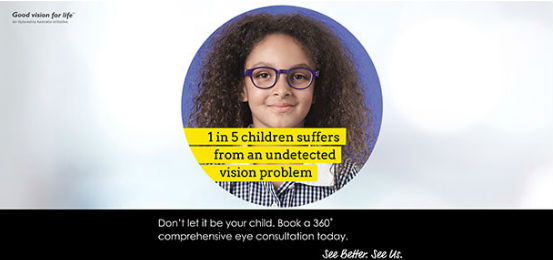Common Eye Conditions
Glaucoma is a common eye condition and one of Australia’s major causes of blindness. It can affect anyone, at any age, with the risk increasing from about the age of 40.
Glaucoma is a disease of the eye which slowly and permanently destroys the optic nerve at the back of the eye. In most people this damage is due to an increased pressure inside the eye. In other patients the damage may be caused by poor blood supply to the vital optic nerve fibres, a weakness in the structure of the nerve, and/or a problem in the health of the nerve fibres themselves. Eye pressures vary from person to person: there is no such thing as a “normal” pressure.
Generally there are no warning signs or pain associated with glaucoma. The loss of sight is gradual and a considerable amount of peripheral (side) vision may be lost before the person becomes aware of any problem.
Glaucoma is detected by your Optometrist measuring the pressure in the eye, checking the nerve structure at the back of the eye, assessing the drainage angles of the eye and checking the thickness of the cornea. If the Optometrist feels an extra test is needed, they will perform a visual fields tests.
Glaucoma cannot be cured but in most cases can be controlled successfully. This is a life-long condition requiring continuing observation and management to keep ocular pressure under control and to prevent loss of vision or further loss of vision.
Vision damaged by glaucoma is irreversible.
For further information on Glaucoma please refer to www.glaucoma.org.au
Macular Degeneration causes progressive macular damage resulting in loss of central vision but the peripheral vision is not affected.
The macula is the central part of the retina, the light sensitive tissue at the back of the eye. The retina processes all visual images. It is responsible for your ability to read, recognise faces, drive and see colours clearly. You are reading this passage using your macula.
Macular Degeneration is the leading cause of blindness and severe vision loss in Australia. One in seven people over the age of 50 years is affected in some way and the incidence increases with age.
There are 2 types of Macular Degeneration. The DRY form results in a gradual loss of central vision. The WET form is characterised by a sudden loss of vision and is caused by abnormal blood vessels growing into the retina. Immediate medical treatment is essential if symptoms occur.
Macular Degeneration is thought to be caused by genetic and environmental factors. People over the age of 50 years are at risk. If you smoke or have a family history of macular degeneration, your risk of developing the disease is much greater.
The early detection of any form of macular degeneration is crucial because the earlier you seek treatment, the more likely you are to have a better outcome compared to those who wait. Macular Degeneration can cause many different symptoms. Difficulty with your vision should not be dismissed as part of just getting older. Early detection can allow you to take steps to slow the progression of Macular Degeneration.
For further information please refer to www.mdfoundation.com.au
Cataracts are a cloudiness that form in the lens of the eye. The lens normally is clear. Poor vision results because the cloudiness interferes with light entering the eye.
Most cataracts are a result of ageing and long-term exposure to ultraviolet light. Some are caused by injury and certain diseases and in rare cases by exposure to toxic materials and radiation. Occasionally cataracts are present at birth, due to the baby’s mother having had rubella during the pregnancy, or genetic defects.
The clouded areas become larger and denser and cause the patient’s sight to become worse. The time taken for this to happen varies from a few months to many years.
Usually cataracts affect both eyes but often develop at different rates in each eye.
People older than 65 years often have signs of cataracts and should have their eyes examined regularly.
If untreated, cataracts can cause blindness. Blindness can be prevented by detecting the cataracts early and, if necessary, by having them removed surgically.
Most patients have an intra-ocular lens inserted at the time of surgery, with excellent results. This is a plastic lens that replaces your own cloudy lens. Patients may also need to wear spectacles or contact lenses.
Usually the development of cataracts is gradual with a painless worsening of sight. Other symptoms include blurred or hazy vision, spots before the eyes, double vision and a marked increase in sensitivity to glare.
An examination by your Russell will reveal any changes that have occurred in the lens of the eye. We have special equipment that enables us to see changes in the lens that may lead to cataracts several years before any symptoms appear.
(Optometrists Association Australia)
More than one million Australians have diabetes. Of these, more than 70% will develop some changes in their eyes within 15 years of diagnosis. Optometrists play a fundamental role in diagnosing these conditions in their early stages when they respond best to treatment.
Diabetes sometimes causes the focusing ability of the eye to weaken or to fluctuate from day to day. The problem eases when blood sugar levels are controlled by a doctor. After diabetes has been present for some years, changes may occur at the back of the eye in the retina.
An Ophthalmoscope is used to check for these changes, which are known as diabetic retinopathy. The risk of developing retinopathy increases with the length of time you have had diabetes.
The risk is also increased by poor control of blood sugar levels. It is advisable for all people with diabetes to have yearly eye examinations. Diabetes can increase your chances of developing certain vision conditions, such as; Double Vision, Glaucoma, Cataracts.
(Optometrists Association Australia)







